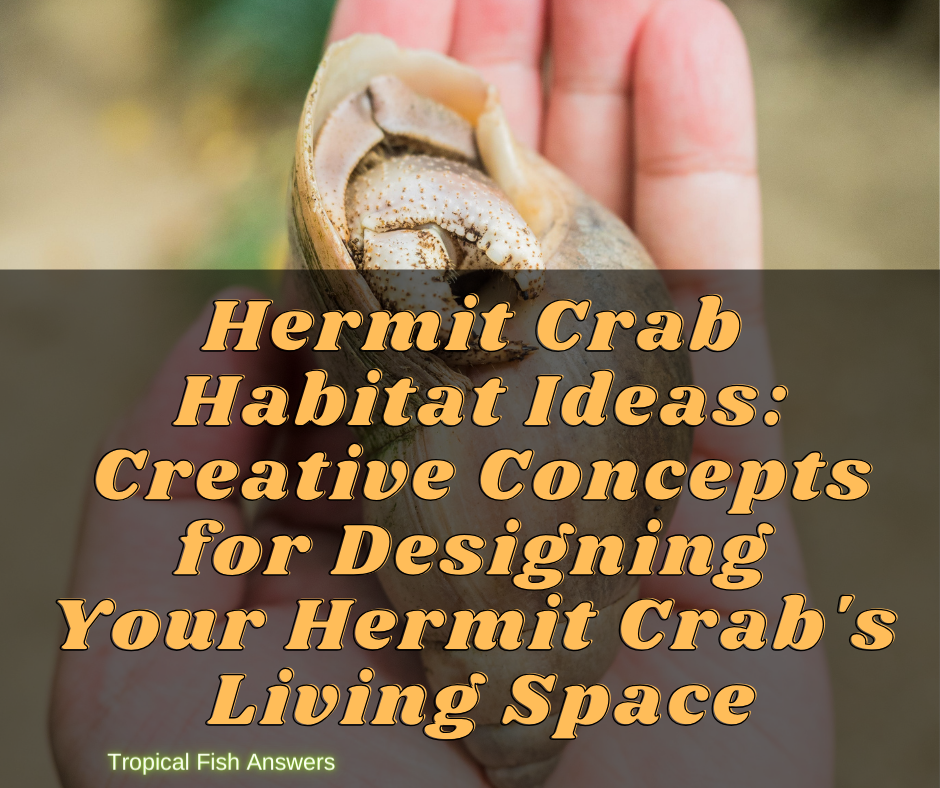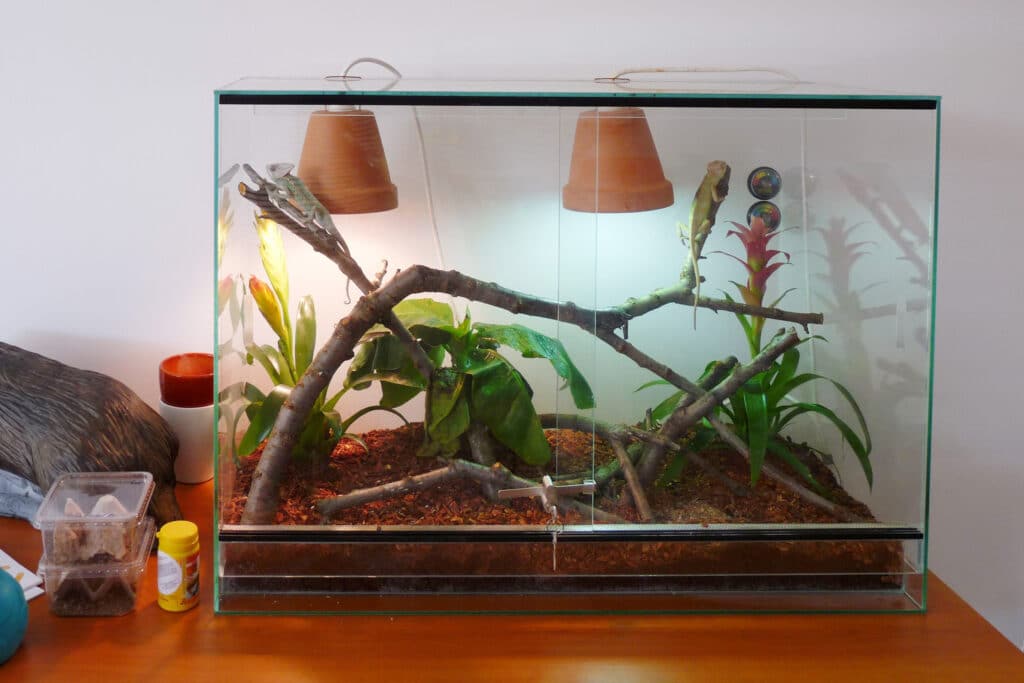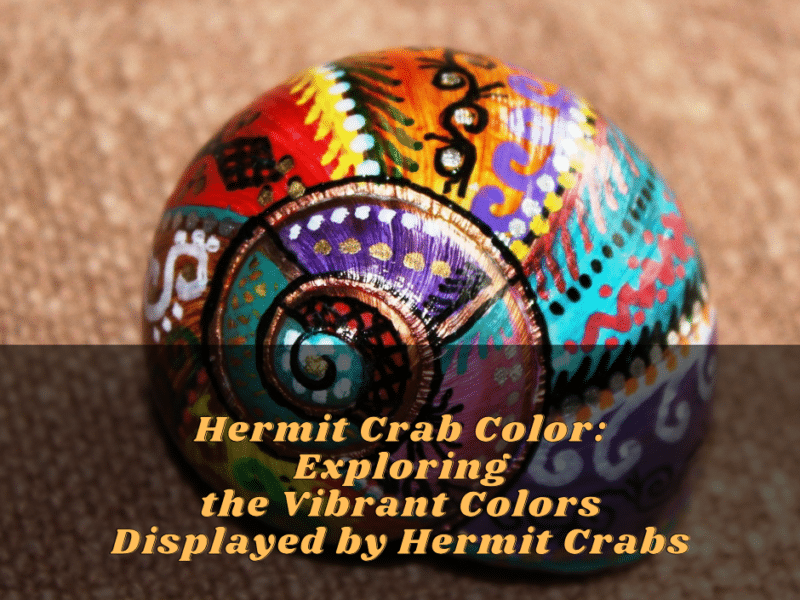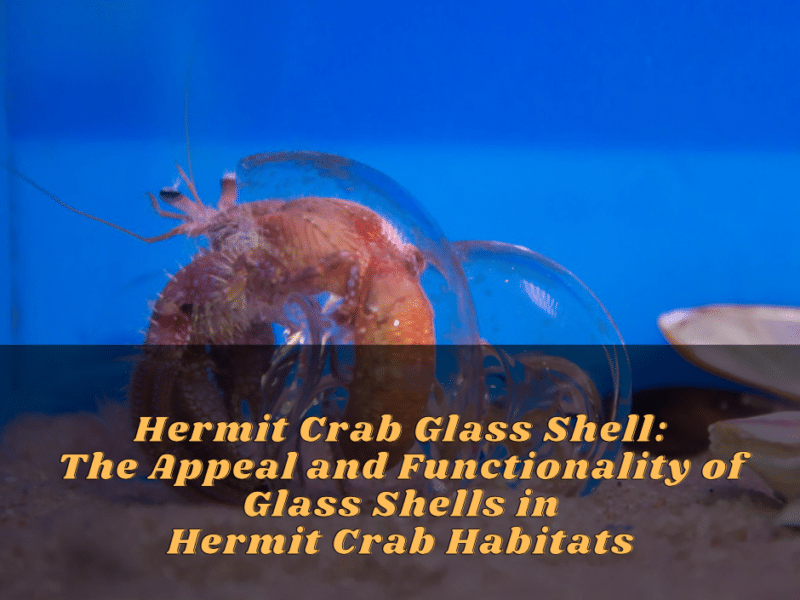Introduction
Creating a well-designed habitat for your hermit crab is crucial for their overall well-being and happiness. Hermit crabs are highly adaptable creatures that rely on their living environment to meet their physical and psychological needs. In this article, we will explore the importance of a well-designed hermit crab habitat and provide some creative concepts for designing a space that best suits your crab’s needs.
Hermit Crab Habitat Ideas – Why A Well-designed Hermit Crab Habitat Is Important
A hermit crab’s habitat plays a vital role in their overall health and happiness. Here are a few reasons why a well-designed habitat is important:
- Replicating their natural environment: Hermit crabs are native to coastal areas and tropical forests. By recreating a habitat that resembles their natural environment, you provide them with a sense of security and comfort.
- Promoting physical health: A properly designed habitat incorporates elements such as climbing structures, hiding spots, and adequate substrate depth. These features encourage natural behaviors, exercise, and molting, which are essential for their physical health.
- Providing mental stimulation: Hermit crabs are intelligent creatures that require mental stimulation. Including various elements like toys, shells, and interactive features in their habitat can keep them engaged and prevent boredom.
What To Consider When Designing A Hermit Crab’s Living Space
When designing your hermit crab’s living space, consider the following factors:
- Size and space: Hermit crabs require ample space to move around and explore. Make sure the habitat is large enough to accommodate their size and allow for future growth.
- Substrate: Choose a suitable substrate that mimics their natural habitat, such as coconut fiber or a sand and soil mix. The substrate should be deep enough for burrowing and molting.
- Climbing structures: Provide climbing structures like rocks, driftwood, or branches to encourage natural climbing behavior. These structures also double as hiding spots.
- Hiding spots: Hermit crabs need hiding spots to retreat and molt comfortably. Adding shells, caves, or tunnels to the habitat ensures they have a safe and secure space.
- Humidity and temperature: Maintain the appropriate humidity and temperature levels based on the specific species of hermit crab you have. Research their native habitat to replicate these conditions.
- Water and food areas: Include areas for fresh and saltwater dishes, as well as designated spaces for food placement. This ensures easy access to essential resources.
- Decoration: Add natural elements like plants, moss, or rocks to create a visually appealing habitat. Be mindful of using non-toxic materials to ensure the safety of your hermit crab.
By considering these factors when designing your hermit crab’s habitat, you can create a space that promotes their well-being and allows them to thrive in a comfortable and stimulating environment.
Enclosure Options
Different Types Of Habitats For Hermit Crabs
When designing a hermit crab’s living space, you have several enclosure options to choose from. Each type has its own advantages and considerations. Here are some different habitats for hermit crabs:
- Glass Tanks: Glass tanks are a popular choice as they provide excellent visibility and insulation. They are easy to clean and maintain, and their transparency allows you to observe your hermit crab’s activities. However, proper ventilation is crucial to prevent condensation and maintain appropriate humidity levels.
- Plastic Containers: Plastic containers are lightweight and affordable, making them a budget-friendly option. They are also easy to secure and transport. However, plastic containers may not provide as much insulation as glass tanks, and they may require additional measures to maintain proper humidity.
- Wire Cages: Wire cages offer excellent ventilation, which is important for hermit crabs. They allow for better airflow and reduce the risk of condensation. However, it’s essential to choose a cage with small enough gaps to prevent the hermit crab from escaping.
- Wooden Terrariums: Wooden enclosures can provide a natural and aesthetically pleasing habitat for hermit crabs. They provide insulation and retain moisture well. However, it’s important to choose a non-toxic type of wood and ensure proper sealing to prevent moisture damage.
Pros And Cons Of Plastic, Wire, Glass, And Wood Enclosures
Here is a breakdown of the pros and cons of each enclosure type:
- Glass Tanks:
Pros: Great visibility, insulation, and easy maintenance.
Cons: Condensation issues, risk of poor ventilation if not properly set up. - Plastic Containers:Pros: Lightweight, affordable, and easy to secure and transport.Cons: May not provide sufficient insulation, may require additional measures to maintain humidity.
- Wire Cages:Pros: Excellent ventilation, better airflow, and reduced condensation.Cons: Gaps should be small enough to prevent escape, limited visibility.
- Wooden Terrariums:Pros: Natural and aesthetically pleasing, good insulation and moisture retention.Cons: Requires careful choice of non-toxic wood and proper sealing to prevent moisture damage.
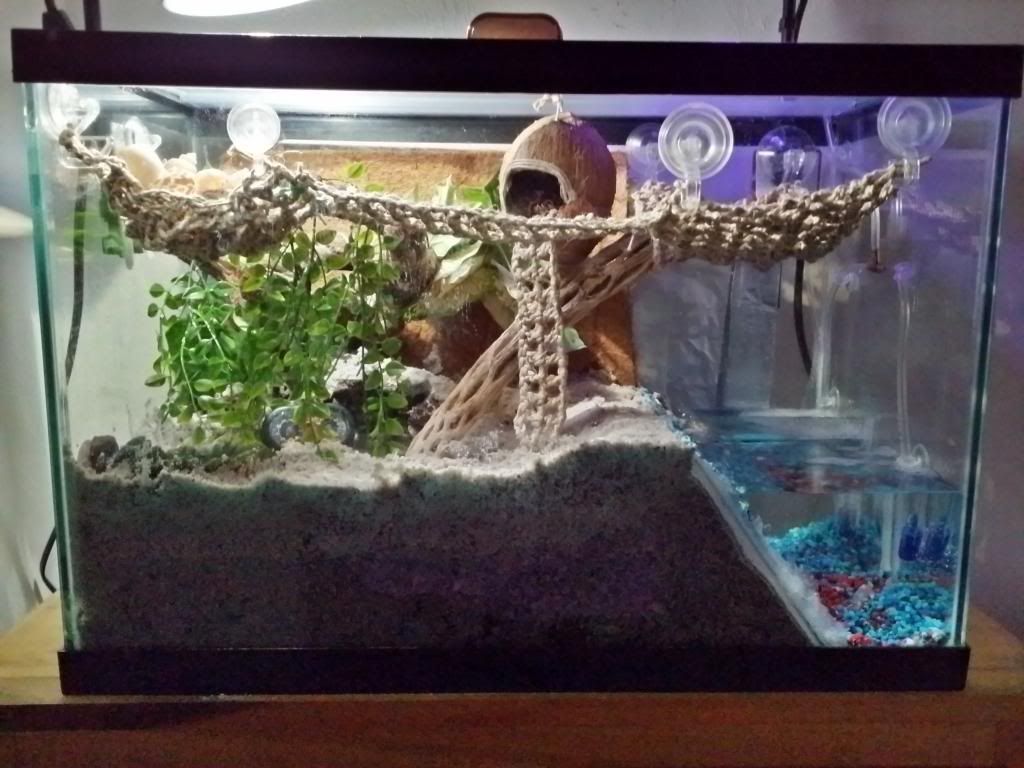
Consider the specific needs and preferences of your hermit crab, as well as your budget and aesthetics when choosing the enclosure. Remember to provide ample space, appropriate substrate, climbing structures, hiding spots, and other essentials to ensure your hermit crab’s well-being in their new habitat.
Decor And Accessories
Essential Items For A Hermit Crab Habitat
Creating a suitable habitat for your hermit crab involves more than just choosing the right enclosure. It is important to provide essential items that mimic their natural environment and promote their well-being. Here are some must-have accessories for your hermit crab’s habitat:
- Substrate: Choose a substrate that replicates their natural habitat. A combination of sand and coconut fiber works well, providing them with a comfortable surface to burrow and molt.
- Shelter: Hermit crabs need hiding spots to feel safe and secure. Place various sized shells, cork bark, and moss in the enclosure to create hiding places and climbing structures for them.
- Water Dish: Provide a shallow dish of freshwater for drinking and bathing. Make sure the dish is large enough for the hermit crab to easily submerge itself and is positioned securely to prevent tipping.
- Food Dish: Use a shallow dish for feeding to keep the food clean and easily accessible. Opt for a dish with sloped sides to prevent the hermit crab from tipping it over.
- Heating and Humidity: Hermit crabs require specific temperature and humidity levels to thrive. Install a heat pad or lamp on one side of the enclosure to provide a warm area, and use a hygrometer to monitor humidity levels.
Innovative Ideas For Creating A Stimulating Environment
To make your hermit crab’s habitat more interesting and engaging, consider adding some creative elements to stimulate their natural behaviors and instincts. Here are a few innovative ideas:
- Climbing Structures: Place branches, driftwood, or rocks in the enclosure to create climbing opportunities for your hermit crab. This will encourage exercise and mimic their natural environment.
- Enrichment Toys: Introduce toys such as plastic tunnels, puzzle feeders, or small objects for them to explore and play with. These toys can provide mental stimulation and prevent boredom.
- Natural Foliage: Add live plants or artificial plants to create a more natural and visually appealing habitat. Ensure that any live plants are safe and non-toxic for hermit crabs.
- Shells and Ornaments: Place additional shells in the enclosure for your hermit crab to explore and potentially change into. Adding small ornaments, like miniature pirate ships or treasure chests, can also add some whimsy to their environment.
Remember, providing a stimulating and comfortable environment for your hermit crab is essential for their overall well-being. Regularly observe and interact with your hermit crab to ensure they are thriving in their habitat, and make any adjustments necessary to meet their changing needs.
DIY Hermit Crab Habitats
Creating a suitable habitat for your hermit crab involves more than just choosing the right enclosure. It is an opportunity to get creative and design a living space that not only meets their physical needs but also provides stimulation and enrichment. Here, we will explore some step-by-step guides on making a homemade hermit crab habitat and creative concepts for repurposing furniture and other materials.
Step-by-step Guide To Making A Homemade Hermit Crab Habitat
- Choose the right enclosure: Opt for a glass or plastic tank that is spacious enough to accommodate your hermit crab’s needs. Ensure it has a secure lid to prevent escape.
- Create a suitable substrate: Combine sand and coconut fiber to replicate the hermit crab’s natural habitat. This will provide a comfortable surface for burrowing and molting.
- Add hiding spots: Place various-sized shells, cork bark, and moss in the enclosure to create hiding places and climbing structures. These will help your hermit crab feel safe and secure.
- Provide food and water dishes: Use shallow dishes for food and water, ensuring they are securely positioned. Opt for dishes with sloped sides to prevent tipping.
- Monitor temperature and humidity: Install a heat pad or lamp on one side of the enclosure to create a warm area. Use a hygrometer to monitor and maintain the ideal humidity levels.
Creative Concepts For Repurposing Furniture And Other Materials
If you’re looking to add a unique touch to your hermit crab habitat, consider repurposing furniture and other materials. Here are some creative ideas:
- Upcycled storage containers: Convert old drawers, wooden crates, or plastic storage containers into multi-level habitats. Add mesh or holes for ventilation and create different compartments for food, water, and hiding spots.
- Repurposed terrariums: Transform old terrariums or fish tanks into custom hermit crab habitats. Enhance the visual appeal by adding natural elements like live plants, rocks, and driftwood.
- DIY climbing structures: Use PVC pipes, tree branches, or bamboo sticks to create climbing structures within the enclosure. This will provide exercise opportunities for your hermit crab while mimicking their natural environment.
- Unique hideouts: Repurpose items like coconut shells, seashells, or small ceramic pots to create creative and visually appealing hiding spots for your hermit crab.
Remember, when designing DIY hermit crab habitats, prioritize the safety and comfort of your pet. Ensure any materials used are non-toxic and free from sharp edges. Regularly assess the habitat to make adjustments and improvements as needed to ensure the well-being and happiness of your hermit crab.
Enhancing The Habitat
When it comes to creating a hermit crab habitat, there are endless possibilities for enhancing their living space. By incorporating various elements such as climbing structures, hiding spots, and toys, you can provide your hermit crab with a stimulating and enriching environment. Here, we will explore the benefits of these additions and offer some creative ideas for designing your hermit crab’s living space.
Adding Climbing Structures, Hiding Spots, And Toys To The Habitat
Climbing structures not only mimic the hermit crab’s natural environment but also provide them with exercise opportunities. PVC pipes, tree branches, and bamboo sticks can be used to create interesting and sturdy structures within the enclosure. These structures encourage physical activity and help to prevent boredom.
Hiding spots are essential for hermit crabs as it offers them a sense of security. Coconut shells, seashells, or small ceramic pots can be repurposed to create unique and visually appealing hideouts. These hiding spots provide a safe space for the hermit crab to retreat to when they feel stressed or threatened.
Toys can also be added to the hermit crab habitat to provide mental stimulation. Small balls, plastic tunnels, or even simple puzzles can entertain the hermit crab and keep them occupied. These toys encourage exploration and can help prevent stress-related behaviors.
Benefits Of Incorporating Rope Ladders, Bridges, And Water Pools
Rope ladders and bridges are great additions to the hermit crab habitat as they offer additional climbing opportunities. Climbing up and down these structures mimics the crab’s natural behavior and helps to simulate their natural habitat. It also provides exercise and keeps them active and engaged.
Water pools are another beneficial addition to the hermit crab habitat. These can be shallow dishes or even small containers with a ramp for easy access. Hermit crabs enjoy soaking in water to maintain the moisture levels in their gills. Providing a water pool allows them to regulate their body hydration, and it adds an extra element of enrichment to their habitat.
By incorporating these elements, you can design a diverse and engaging living space for your hermit crab. Remember to regularly assess the habitat to ensure the safety, comfort, and well-being of your pet. Make adjustments and improvements as needed to create a habitat that suits their unique needs. With a well-designed habitat, your hermit crab will thrive and enjoy a fulfilling life in their new home.
Inspiring Crabitat Ideas
If you are a hermit crab owner, you know that enhancing their habitat is essential for their well-being. A creatively designed living space can provide your hermit crab with a stimulating and enriching environment. Here, we will explore some inspiring crabitat ideas that will not only meet the needs of your hermit crab but also add a touch of uniqueness and aesthetics to their living space.
Inspiration From Unique And Aesthetically Pleasing Hermit Crab Habitats
Looking for inspiration? Take a cue from some exceptional hermit crab habitats that showcase creativity and attention to detail. These habitats go beyond the traditional setup and incorporate unique elements. For example, you can create a beach-themed habitat with a sandy substrate, seashells, and miniature palm trees. Or, you could design a jungle-inspired habitat by adding live plants, vines, and tree branches. The possibilities are endless, so let your imagination run wild and create a habitat that reflects your personal style and your hermit crab’s natural environment.
DIY Hacks And Projects To Personalize Your Crab’s Living Space
If you enjoy do-it-yourself projects, there are plenty of DIY hacks and ideas to personalize your hermit crab’s living space. For instance, you can repurpose old picture frames or shadow boxes to create climbing walls or vertical hideouts. Another idea is to make mini hammocks using fabric scraps or crochet materials for your hermit crab to lounge on. You can also build custom hiding spots using materials like clay pots or driftwood. These DIY projects not only add a personal touch to the habitat but also provide your hermit crab with additional enrichment and comfort.
Remember to ensure that any materials used in the crabitat are safe and non-toxic for your hermit crab. Research and consult with experts if needed to ensure the well-being of your pet. With a little creativity and resourcefulness, you can create a crabitat that will not only meet your hermit crab’s needs but also be a visually appealing addition to your home.
In conclusion, enhancing the habitat of your hermit crab is an exciting opportunity to create a unique and engaging living space. Draw inspiration from various sources and unleash your creativity to design a crabitat that reflects your style and provides the stimulation and enrichment your hermit crab needs to thrive. Happy designing!
Maintaining A Healthy Crabitat
Ensuring a clean and safe habitat for your hermit crab is essential for their health and well-being. In this section, we will provide you with some tips on how to keep their habitat clean and safe, as well as discuss feeding and watering considerations to ensure their overall well-being.
Tips For Keeping The Hermit Crab Habitat Clean And Safe
- Regular Cleaning: Clean the habitat regularly by removing any uneaten food, molting exoskeletons, and debris. Change the substrate every few months to prevent bacterial growth and odor.
- Avoid Chemicals: Use safe and non-toxic cleaning products when cleaning the habitat. Avoid using chemicals that can harm your hermit crab or disrupt their delicate environment.
- Provide Fresh Water: Offer fresh, dechlorinated water in a shallow dish at all times. Make sure the water is not too deep for your hermit crab to drown and regularly check and refill the dish to ensure cleanliness.
- Ensure Proper Humidity: Hermit crabs require a specific level of humidity in their habitat. Use a hygrometer to monitor humidity levels and adjust as necessary. Provide a separate area with moistened sand or moss for them to molt.
- Separate Food and Water: Place the food dish away from the water dish to prevent contamination. Remove any uneaten food promptly to avoid attracting pests or causing bacterial growth.
Feeding And Watering Considerations For Their Well-being
- Diet Variety: Offer a diverse diet to ensure your hermit crab receives essential nutrients. This can include commercial hermit crab food, fresh fruits, vegetables, and protein sources like freeze-dried shrimp or mealworms.
- Calcium and Protein: Provide a calcium source, such as cuttlebone, and protein-rich foods like eggs or fish to support their shell and muscle growth.
- Monitor Food Consumption: Pay attention to how much food your hermit crab consumes. Remove any uneaten food to maintain a clean habitat and prevent mold or bacterial growth.
- Change Water Regularly: Replace the water in the dish daily to ensure freshness and cleanliness. Use dechlorinated water and consider adding a small amount of marine salt to mimic their natural environment.
By following these tips, you can maintain a clean and safe habitat for your hermit crab, promoting their overall health and well-being. Remember to observe their behavior and make adjustments accordingly to ensure they have the best possible environment to thrive in.
Conclusion
Creating a healthy and stimulating habitat for your hermit crab is vital for their overall well-being. By following the tips outlined above, you can ensure that their living space is clean, safe, and enjoyable. But it doesn’t end there. It’s also important to consider the importance of providing a creative and stimulating habitat for your hermit crab, as well as creating a harmonious and enjoyable environment for both you and your pet.
The Importance Of Providing A Creative And Stimulating Habitat For Your Hermit Crab
Hermit crabs are active and curious creatures that thrive in an environment that offers plenty of opportunities for exploration and stimulation. By incorporating creative elements into their habitat, you can provide them with a more enriching experience. Consider adding features such as climbing branches, tunnels, and hiding spots to encourage natural behaviors and keep them engaged.
In addition, incorporating different textures and materials in their environment, such as sand, shells, and rocks, can mimic their natural habitat and provide a more stimulating experience. These elements can also contribute to their overall well-being by promoting exercise and mental stimulation.
Creating A Harmonious And Enjoyable Environment For Both You And Your Pet
Designing your hermit crab’s living space is not just about meeting their needs; it’s also an opportunity for you to enjoy the process. Get creative with the design by adding decorative elements such as plants, shells, and colorful substrates. This can not only enhance the visual appeal of the habitat but also create a soothing and relaxing atmosphere for you to enjoy.
Remember to choose materials that are safe for your hermit crab and avoid using any toxic substances or decorations that could harm them. By creating a harmonious and enjoyable environment, you can create a space that not only benefits your hermit crab but also brings joy and relaxation to your own life.
In conclusion, by providing a creative and stimulating habitat for your hermit crab, you are ensuring their physical and mental well-being. Furthermore, creating a harmonious and enjoyable environment benefits both you and your pet, fostering a greater bond and enhancing the overall experience of keeping a hermit crab as a pet. So get creative, have fun, and design a living space that both you and your hermit crab will love.
FAQ about Hermit Crab Habitat Ideas: Creative Concepts for Designing Your Hermit Crab’s Living Space
Q: What are some easy DIY hermit crab tank ideas?
A: There are numerous easy DIY hermit crab tank ideas that you can try. These ideas range from using a tank, aquarium, wood, wire cage, glass display case, or even repurposing a piece of furniture. You can get creative and design a habitat that suits your hermit crabs’ needs and preferences.
Q: Where can I find inspiration for hermit crab habitats?
A: You can find inspiration for hermit crab habitats online by searching for “crabitat ideas” or “hermit crab habitat” on platforms like Pinterest or search engines like Yahoo. There are also websites dedicated to providing guides and ideas for creating the perfect hermit crab habitat.
Q: What materials can I use to decorate my hermit crab’s habitat?
A: When it comes to decorating your hermit crab’s habitat, the choices are endless. You can use items such as rope ladders, bridges, water pools, fishing nets, Hermie Huts, and crab shacks to create an engaging and stimulating environment for them. Be sure to choose materials that are safe for your hermit crabs and won’t harm them.
Q: How can I ensure a healthy and happy hermit crab habitat?
A: To ensure a healthy and happy hermit crab habitat, it is essential to provide plenty of opportunities for exploration, climbing, inspection, and hiding. Incorporate various levels and hiding spots for your hermit crabs to feel secure. Additionally, make sure you maintain the appropriate temperature, humidity, and substrate in the habitat to mimic their natural environment.
Q: Can I use items from my local pet store to enhance my hermit crab’s habitat?
A: Absolutely! Pet stores often carry a wide variety of items that can enhance your hermit crab’s habitat. Look for climbing structures, hiding places, and toys specifically designed for small pets. However, always double-check that these items are safe and suitable for hermit crabs before purchasing them.
Q: How can I make my hermit crab’s habitat more interactive and fun?
A: Making your hermit crab’s habitat interactive and fun is easy. You can incorporate puzzle toys, food enrichment activities, and even create mini obstacle courses using safe materials. Observing your hermit crabs interact with these additions can provide entertainment and joy for both you and your hermit crabs.
Remember, creating a hermit crab habitat is not only about designing an aesthetically pleasing space but also about providing a safe and enriching environment for your pet. By following these ideas and guidelines, you can create a habitat that your hermit crabs will love to explore and call home.
